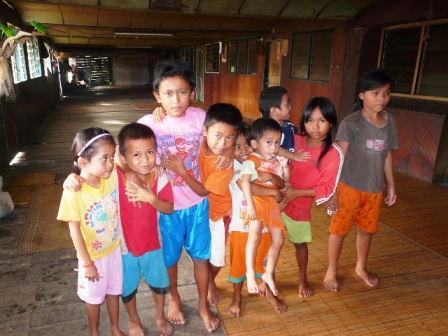|
Dec 12 2008
Ray wanted to turn around and go back to Kapit when he first sighted
Weng Longhouse, our home for the next two days. He needed a little time
to get used to going back to a more primitive time where life is slow
and simple. This is what we had come upriver from Kapit to see and
experience, a genuine Longhouse where people live pretty much as they
always did. We did stay. The people at Weng were friendly and welcoming
and the food was different but very tasty. It was just that we hadn't
expected their living conditions to be quite that simple. We are used to
more western comforts and the traditional Longhouses have few luxuries.
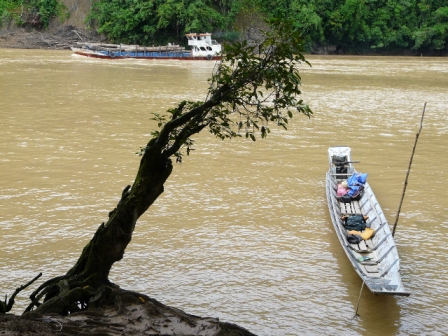 Joshua, the local Longhouse agent and guide, assured us that we would
have the best possible experience if we went by boat to Weng Longhouse
and spent three days and two nights with the 8 or so Iban tribal
families living there. It was more expensive that we had expected but we
agreed to go the next day.
Our
boatman Kabau was right on time at noon. We left most of our luggage
with Joshua and took only a daypack of clothing with us. We had seen
quite a few of these simple long, flat-bottomed, wooden dug-out style
boats but this was our first experience travelling in one. Joshua helped
load our belongings plus food, cookies and treats for the children, and
at his insistence, some cheap wine for the men. The 15 hp motor meant
that we had plenty of time to enjoy the sights on our 2 hour jouney
along the river and we were relatively comfortable sitting on life
jackets on the bottom of the boat. Joshua, the local Longhouse agent and guide, assured us that we would
have the best possible experience if we went by boat to Weng Longhouse
and spent three days and two nights with the 8 or so Iban tribal
families living there. It was more expensive that we had expected but we
agreed to go the next day.
Our
boatman Kabau was right on time at noon. We left most of our luggage
with Joshua and took only a daypack of clothing with us. We had seen
quite a few of these simple long, flat-bottomed, wooden dug-out style
boats but this was our first experience travelling in one. Joshua helped
load our belongings plus food, cookies and treats for the children, and
at his insistence, some cheap wine for the men. The 15 hp motor meant
that we had plenty of time to enjoy the sights on our 2 hour jouney
along the river and we were relatively comfortable sitting on life
jackets on the bottom of the boat.
We negotiated the Rejang River and two other tributaries, the Balang and
Modong rivers to reach our destination. The rivers were swollen and
muddy from the monsoon rains but the lush vegeation on both banks
created a pretty atmosphere.
Logging
is big business in Borneo and we passed several logging camps on our
way. Since this is the monsoon season when boats can easily negotiate
the rivers, logs were stacked on shore and floating in large booms,
waiting to fill barges that haul them downriver to Kapit and Suri.
Luckily our boat proved to be sturdy and stable. We didn't have any
problem negotiating the wake of these laden barges.
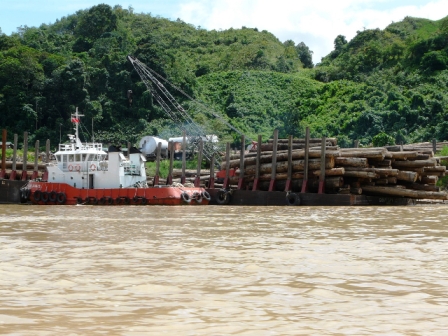
Logs on Modong
river |
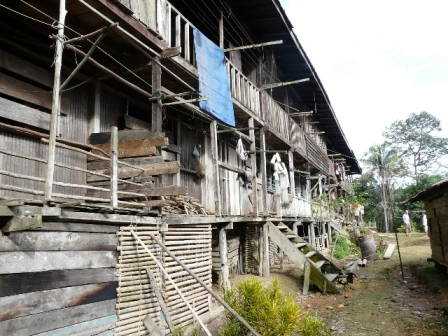
Weng Longhouse |
We
reached Weng Longhouse, docked and carried our belongings up a muddy
bank on a set of rickety wooden stairs, then another set of concrete
steps inlaid with pebbles to counteract the moss that is a
characteristic of a rain forest in the monsoon season. Ahead was our
home for the next two days. A long, unpainted, wooden building with a
corrugated tin roof, fronted by a series of seven doors and windows in
various states of repair, was situated on a ridge with gullies and
forest on other side. There was a second floor to the building but
judging from the laundry hanging from balconies, it looked as if only
two of the upper units were occupied. Several outbuildings, including
chicken coops and outhouses (the toilets) completed the Longhouse site.
We were invited inside to meet the Chief and his extended family,
with whom we would stay. The first door opened to a covered veranda
about 3 M wide, extending the length of the Longhouse. Another set of
doors and windows demarked the living quarters of each family group. The
chief, Balang, greeted us and ushered us through a large living area,
with nary a chair in sight, into a dining area where tea was being
served. We took our places in a circle on a bamboo mat on the floor
while the chief's wife Rua and a few other women, brought glasses, milk
tea and peanut butter to spread on white bread. Our boatman Kabau was
our interpreter as the Longhouse people speak Iban and maybe Malay, but
little English. It didn't matter. We were content to listen and ask the
occasional question via Kabau.
After tea we were free to wander
about the area but we couldn't go very far. The jungle is too dense for
exploring. I was interested in the crafts being performed by a few of
the women. One lady was creating a cover for a water bottle with beads
strung in an intricate traditional pattern.
 Another
woman was making a wide brimmed Vietnamese style hat. She sewed dried
Nipa Palm leaves together to form a large circle with a peak in the
center. Later she would covers the circle with patterned material and
attach a 10 cm wide circular band with a circumference of a head under
the hat. The completed hat is both a sunshade and a rain hat, leaving
the wearer's hands free to work. Another
woman was making a wide brimmed Vietnamese style hat. She sewed dried
Nipa Palm leaves together to form a large circle with a peak in the
center. Later she would covers the circle with patterned material and
attach a 10 cm wide circular band with a circumference of a head under
the hat. The completed hat is both a sunshade and a rain hat, leaving
the wearer's hands free to work.
All the women wear a sarong with
the ends sewed together to form a tube. Some women top this with a
T-shirt, others just tie it above the bust while the two elderly women
at the Longhouse wore theirs tied below their bare breasts, as they had
always done. The men and the children wore modern T-shirts and shorts.
Everyone had flip flops which were removed and left on the veranda.
Several of the men, but none of the women, sported intricately designed
black tatoos on their backs, arms and legs. I didn't get up my nerve to
ask if I could get a photo of their tatoos.
Joshua had suggested
we could offer to help with the daily chores so I helped prepare a dish
for dinner. I was impressed how easily the people worked together. The
kitchen was a small area at the back of the dining area. One woman
peeled, halved and pitted small round fruits about the size of ping pong
balls. My job was to smash the fruit in a mortar and pestle. The pulp
was added to a mixture of garlic and tiny dried fish, also mashed with
the mortar and pestle. I don't have a clue what it was and it wasn't my
favourite dish when it was served later, but the family certainly
enjoyed it.
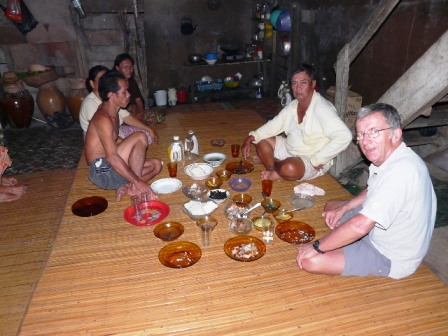 When
Ray, Kabua and I were called to dinner it was obvious we were the
honoured guests. We ate with the chief before anyone else. There were
dishes of rice (of course), chicken prepared with bamboo shoots, fish,
tasty new ferns, a cucumber-like dish, pineapple and the fish-fruit
mixture from which to help ourselves. It was all very good. All meals
are eaten with both hands with a bowl of water provided for each person
to rinse their hands periodically. Our other meals were variations of
this first meal with leftovers enhanced with other greens and a pumpkin
dish. When
Ray, Kabua and I were called to dinner it was obvious we were the
honoured guests. We ate with the chief before anyone else. There were
dishes of rice (of course), chicken prepared with bamboo shoots, fish,
tasty new ferns, a cucumber-like dish, pineapple and the fish-fruit
mixture from which to help ourselves. It was all very good. All meals
are eaten with both hands with a bowl of water provided for each person
to rinse their hands periodically. Our other meals were variations of
this first meal with leftovers enhanced with other greens and a pumpkin
dish.
After dinner that evening everyone gathered on bamboo mats
on the veranda. The generator started up and florescent lights provided
light. More families arrived as they finished their meals and one man,
who we called the Party Animal, arrived with a large bottle of home-made
hooch. It tasted like a mixture of wine and fruit juice and wasn't bad,
although one glass was enough for me. There were stories told and
through Kabua we asked questions of each other. It was still difficult
to determine which child belonged to which parent as the children
flitted in and out of the group, to sitting on the lap of whomever would
welcome them. We never did figure out if the elderly woman in the
chief's home was a mother or grandmother but it didn't matter to the
Longhouse community. Everyone was cared for with patience and love.
Each person showers either before or after dinner. The shower room
for the women was the open back porch off the kitchen. Running water was
a faucet set over a large pail. You use a smaller container as a scoop
and pour the water over your head all the while wearing your sarong, no
nudity here. We managed to stay clean regardless.
The question of
where we would sleep was solved about 9 PM when most people retired.
Sleeping mattresses that had been rolled up against one wall of the
living area were laid on the floor with a mosquito net hung over each
bed. Three double mattresses were along one wall and Ray and I shared a
fourth foam mattress laid against the opposite wall. It was actually
very comfortable.
The
next morning we asked Kabua if he could take us to see another
Longhouse. He agreed and we set off upriver to Ensriban Longhouse, a
short distance away. This was a much larger community consisting of
three longhouses joined by short walkways. It may have been larger but
it wasn't any fancier. The rooms were larger but the buildings were
still unpainted weathered wood and power was available only with a
generator, but they did have chairs! I think that is what we missed the
most. Our joints complain about sitting cross legged and our bodies do
not take very well to hard floors.
Of course we had to come
inside and join them in refreshments of tea or coffee and a snack. We
were then free to wander about and explore.
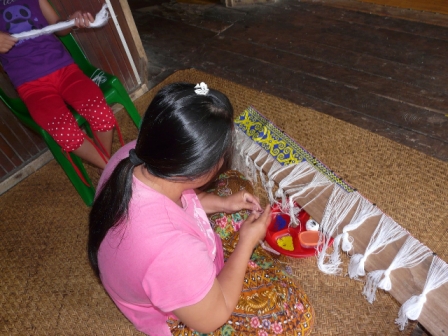 The
women in this longhouse also did intricate beadwork. We watched two
groups work on long ceremonial sashes to be worn by the men for special
occasions. A few of the older women were chewing betel nut and insisted
I try some. They rolled leaves into a little packet, added some powder
and gave it to me. It wasn't bad. I didn't chew it long for fear my
teeth would be permanently stained red. The
women in this longhouse also did intricate beadwork. We watched two
groups work on long ceremonial sashes to be worn by the men for special
occasions. A few of the older women were chewing betel nut and insisted
I try some. They rolled leaves into a little packet, added some powder
and gave it to me. It wasn't bad. I didn't chew it long for fear my
teeth would be permanently stained red.
Our afternoon spent
reading and writing notes was interrupted by a group of curious kids but
we didn't mind. December is vacation time in Malaysia so they were home
amusing themselves. They like hopscotch and choose turns with Paper,
Rock and Scissors as our children do but they do not
have many store bought toys. Rocks to play
a version of jacks and wooden tops are about the limit. They were eager
to try out their English which they learn at school. After singing a few
English songs like Row, Row Your Boat, I got them singing Iban songs, at
which they were much better. I asked them their names and had one older
girl write them in my notebook. That led to learning new English words
and them telling me the Iban words. I will remember far less than they
will. They loved having their photo taken and were eager to see all the
photos I have taken on this trip, especially the ones of Singapore and
Malaysia, places they are familiar with.
We were all ready to
leave right after breakfast the next morning but we delayed our
departure. The chief's wife Rua had assumed we would be with them until after noon and
had killed and cleaned a chicken for our lunch. We of course couldn't
leave until we had an early meal of this treat. Then we could say our
goodbyes.
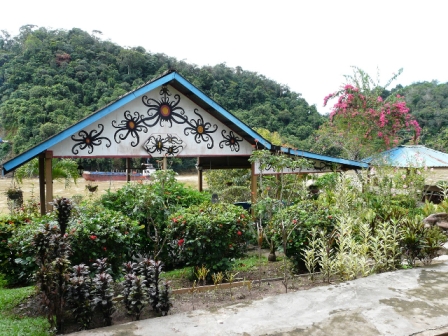 We
motored down the river, stopping at to visit Mujong, a community at the
confluence of the Balang and Modong rivers that had sparked our
curiousity on the way up. Started as a missionary project by the
American Methodist Church in the 1940s, it now comprises a small medical
clinic, the local school and a church. The medical clinic is set amongst
nicely landscaped gardens. The director of the clinic was pleased to
show around and explain their operation. The are funded by the
government and service a population of about 6,000 people who live in 60
Longhouses and several logging camps within a 7 km radious. Most of
their work consists of innoculations for children, childbirths or minor
illnesses. Any serious injuries or illnesses are sent to a larger clinic
a distance away. The operation was very quiet the day we visited but
they were ready for any eventuality. We
motored down the river, stopping at to visit Mujong, a community at the
confluence of the Balang and Modong rivers that had sparked our
curiousity on the way up. Started as a missionary project by the
American Methodist Church in the 1940s, it now comprises a small medical
clinic, the local school and a church. The medical clinic is set amongst
nicely landscaped gardens. The director of the clinic was pleased to
show around and explain their operation. The are funded by the
government and service a population of about 6,000 people who live in 60
Longhouses and several logging camps within a 7 km radious. Most of
their work consists of innoculations for children, childbirths or minor
illnesses. Any serious injuries or illnesses are sent to a larger clinic
a distance away. The operation was very quiet the day we visited but
they were ready for any eventuality.
Return to
Borneo Into
Return to
Malaysia-Thailand Intro
Return to Travels
Return to Introduction
|
